 As the year draws to a close, many people are asking me for rituals to ensure luck and prosperity in the New Year. I enjoy doing prosperity spells myself this time of year. Recently I was speaking with my friend Tamás who is a talented eclectic magician and he shared with me a money and luck ritual he’d developed which he calls his “Golden Touch Hand Wash.” The idea is similar to using floor washes or sprinkling herbal infusions around your home to bring luck and prosperity but with the hand wash, you soak your hands in a blessed herbal liquid that confers a “golden touch” that will bring luck and success to your business projects, money making endeavors as well as in the lottery and games of chance. I instantly loved the uniqueness of this magical recipe and tried it for myself with fast and amazing results and I definitely recommend it as part of your end of year prosperity rituals to set the tone for wealth, success and happiness in the New Year.
As the year draws to a close, many people are asking me for rituals to ensure luck and prosperity in the New Year. I enjoy doing prosperity spells myself this time of year. Recently I was speaking with my friend Tamás who is a talented eclectic magician and he shared with me a money and luck ritual he’d developed which he calls his “Golden Touch Hand Wash.” The idea is similar to using floor washes or sprinkling herbal infusions around your home to bring luck and prosperity but with the hand wash, you soak your hands in a blessed herbal liquid that confers a “golden touch” that will bring luck and success to your business projects, money making endeavors as well as in the lottery and games of chance. I instantly loved the uniqueness of this magical recipe and tried it for myself with fast and amazing results and I definitely recommend it as part of your end of year prosperity rituals to set the tone for wealth, success and happiness in the New Year.
You will need:
One teaspoon dried thyme
One teaspoon cinnamon
One teaspoon dried ginger
One teaspoon mustard seeds
7 Cloves
3 Bay Leaves
Handful of dried orange peels
Fill a large pot with water and bring to a roaring boil.
Add all the ingredients and allow to boil for exactly 7 minutes.
Cool and strain.
Reserve the liquid in a pot or basin and once it’s completely cooled submerge your hands in it. Gently splash your hands around in the liquid and make sure they are entirely covered from the wrist down.
Recite the following invocation, “I bathe my hands in this magical mixture and will that it confer onto me the golden touch to make all my business activities flourish and luck abound in my life. So mote it be!”
Allow your hands to dry off naturally.
Cinnamon and ginger and known irritants, so if you have sensitive skin you may want to avoid washing your hands with this mixture. If that is the case, you could still brew the herbal infusion using less water and sprinkle it around your home to bring luck and prosperity.
I hope you have enjoyed this post and I urge you to give the Golden Touch Hand Blessing a try. I can assure you it is a good way to set the tone for luck and wealth in the New Year. As always I thank you for taking the time to visit my blog and I wish you peace, happiness and abundant blessings!
The Magic of the Holiday Season
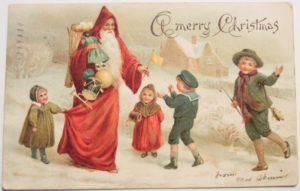 The holiday season is truly a time of magic and whimsy as anyone who has seen the Nutcracker or read Charles Dickens’ A Christmas Carol will confirm. The weeks after Thanksgiving leading to New Years are filled with a tangible energy of peace and harmony that often brings out the kind and charitable side of people even amidst a frenzy of materialistic gift buying. It was not until recently that I’ve realized that on a deeper level, the final weeks of the year are on a deeper level, a time of magic and intensely heightened spiritual activity. This first came to my attention on a snowy late November afternoon in Cluj-Napoca, Romania while I sat sipping eggnog with my friend Elena. Our conversation, as it often does, turned to themes of the occult and supernatural and Elena told me that in traditional Romanian peasant folklore the final days of November into December are considered a time of magic where many important and powerful saints’ have their feast days in close proximity to each other and in years past there was even a belief that farm animals can talk during this special time of the year. In today’s post, we will take a look at a few of the holy and traditions that make this time of year so special and magical.
The holiday season is truly a time of magic and whimsy as anyone who has seen the Nutcracker or read Charles Dickens’ A Christmas Carol will confirm. The weeks after Thanksgiving leading to New Years are filled with a tangible energy of peace and harmony that often brings out the kind and charitable side of people even amidst a frenzy of materialistic gift buying. It was not until recently that I’ve realized that on a deeper level, the final weeks of the year are on a deeper level, a time of magic and intensely heightened spiritual activity. This first came to my attention on a snowy late November afternoon in Cluj-Napoca, Romania while I sat sipping eggnog with my friend Elena. Our conversation, as it often does, turned to themes of the occult and supernatural and Elena told me that in traditional Romanian peasant folklore the final days of November into December are considered a time of magic where many important and powerful saints’ have their feast days in close proximity to each other and in years past there was even a belief that farm animals can talk during this special time of the year. In today’s post, we will take a look at a few of the holy and traditions that make this time of year so special and magical.
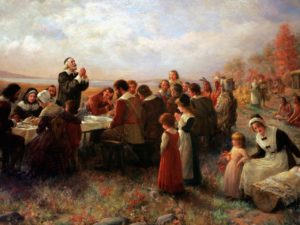 In America, we are used to Thanksgiving kicking off the holiday season. I have always enjoyed Thanksgiving and I definitely feel that having a national day of giving thanks puts us in the mood to be more kind and charitable during the Christmas season in which greed and materialism tend to rear their ugly heads despite the season’s message of love and goodwill towards others. Thanksgiving however is a comparatively new observance compared to the others we will discuss, but I felt it was important to include it since it is highly spiritual in its origins and I do feel that it’s important to have a day where we formally stop our busy activities and give thanks for the blessings we have. I understand and sympathize with many Native-Americas who have a strong dislike for this holiday because of its glorification of colonization which was the beginning of the loss of their land and the decline of their people, but I choose to focus of the aspect of Thanksgiving that teaches us to give thanks to God and each other for the blessing we have in life. I have traveled and lived in many parts of the world and many people have told me that of all the American holidays that have been exported the one that has not been promulgated and that they wish would take root is Thanksgiving since it is a day not of commercialism but of kindness and gratitude.
In America, we are used to Thanksgiving kicking off the holiday season. I have always enjoyed Thanksgiving and I definitely feel that having a national day of giving thanks puts us in the mood to be more kind and charitable during the Christmas season in which greed and materialism tend to rear their ugly heads despite the season’s message of love and goodwill towards others. Thanksgiving however is a comparatively new observance compared to the others we will discuss, but I felt it was important to include it since it is highly spiritual in its origins and I do feel that it’s important to have a day where we formally stop our busy activities and give thanks for the blessings we have. I understand and sympathize with many Native-Americas who have a strong dislike for this holiday because of its glorification of colonization which was the beginning of the loss of their land and the decline of their people, but I choose to focus of the aspect of Thanksgiving that teaches us to give thanks to God and each other for the blessing we have in life. I have traveled and lived in many parts of the world and many people have told me that of all the American holidays that have been exported the one that has not been promulgated and that they wish would take root is Thanksgiving since it is a day not of commercialism but of kindness and gratitude.
 As we inch closer to Christmas, we come to Saint Andrew’s Day which falls on the 30th of November. In many Eastern European countries and in Scotland it is an official holiday. We have touched upon this day in previous posts as Saint Andrew’s Day, and especially the night preceding it, are known to be times of heightened supernatural activity. Saint Andrew was the first called of the apostles and is credited for spreading the gospel to Eastern Europe where his following remains particularly strong to this day. In Romanian folklore, Saint Andrew is the patron saint of vampires and werewolves and offers protection against such creatures that are said to be at their most powerful on the night of the 29th of November, so much so that Romanian peasant hang garlands of garlic around their windows and even rub down the window sills and farm animals with a peeled clove of garlic on this night. Wild roses also offer protection against supernatural creatures of the night. In Poland, Saint Andrew’s Eve is a night of divination especially in matters of love. Molten lead or candle wax are dripped into a basin filled with cold water and information about one’s future spouse is divined according to the shape the lead or wax takes when cooled by the water. In Austrian folklore, it is said that if you go to the apple orchard on St. Andrews Eve and cut a small branch from an apple tree and place it in warm water until it blossoms, you can carry it to the local church and you will be granted the power to see who the village witches are. It seems to me that if a person perform this ritual, he or she might be well on his/her way to becoming the village witch! Of course I love witches of all spiritual paths who use their powers for good and live lives of kindness towards others. I do enjoy St. Andrew’s Eve and Day very much and to me it serves almost like an official end to fall and the beginning of winter and all the beauty that the coldest season brings.
As we inch closer to Christmas, we come to Saint Andrew’s Day which falls on the 30th of November. In many Eastern European countries and in Scotland it is an official holiday. We have touched upon this day in previous posts as Saint Andrew’s Day, and especially the night preceding it, are known to be times of heightened supernatural activity. Saint Andrew was the first called of the apostles and is credited for spreading the gospel to Eastern Europe where his following remains particularly strong to this day. In Romanian folklore, Saint Andrew is the patron saint of vampires and werewolves and offers protection against such creatures that are said to be at their most powerful on the night of the 29th of November, so much so that Romanian peasant hang garlands of garlic around their windows and even rub down the window sills and farm animals with a peeled clove of garlic on this night. Wild roses also offer protection against supernatural creatures of the night. In Poland, Saint Andrew’s Eve is a night of divination especially in matters of love. Molten lead or candle wax are dripped into a basin filled with cold water and information about one’s future spouse is divined according to the shape the lead or wax takes when cooled by the water. In Austrian folklore, it is said that if you go to the apple orchard on St. Andrews Eve and cut a small branch from an apple tree and place it in warm water until it blossoms, you can carry it to the local church and you will be granted the power to see who the village witches are. It seems to me that if a person perform this ritual, he or she might be well on his/her way to becoming the village witch! Of course I love witches of all spiritual paths who use their powers for good and live lives of kindness towards others. I do enjoy St. Andrew’s Eve and Day very much and to me it serves almost like an official end to fall and the beginning of winter and all the beauty that the coldest season brings.
 December 4th is the feast of Saint Barbara. A powerful and legendary saint whom we have discussed previously. Barbara was martyred in the 3rd century by her own father who had previously kept her prisoner in a tower. She is venerated in the Roman Catholic and Orthodox churches throughout Europe and the Middle East. In fact, in Lebanon her feast day takes on a carnival like spirit with costumes, plays and special sweet treats similar to the Jewish celebration of Purim. In Romania, on the eve of St. Barbara’s feast day it is a custom for unmarried women to go to the cherry orchard and cut a twig from a tree and place it in warm water. If the twig blossoms before the New Year, marriage is in store for the year to come. I have noticed that in many of the winter observances of European countries and especially in Scandinavia, it is common to force flower bulbs and other types of plants to bloom out of season perhaps as a reminder amidst the darkest and coldest days of the year that the warm summer months will return.
December 4th is the feast of Saint Barbara. A powerful and legendary saint whom we have discussed previously. Barbara was martyred in the 3rd century by her own father who had previously kept her prisoner in a tower. She is venerated in the Roman Catholic and Orthodox churches throughout Europe and the Middle East. In fact, in Lebanon her feast day takes on a carnival like spirit with costumes, plays and special sweet treats similar to the Jewish celebration of Purim. In Romania, on the eve of St. Barbara’s feast day it is a custom for unmarried women to go to the cherry orchard and cut a twig from a tree and place it in warm water. If the twig blossoms before the New Year, marriage is in store for the year to come. I have noticed that in many of the winter observances of European countries and especially in Scandinavia, it is common to force flower bulbs and other types of plants to bloom out of season perhaps as a reminder amidst the darkest and coldest days of the year that the warm summer months will return.
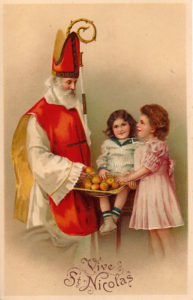 The 6th of December is the feast of Saint Nicholas who of course is the inspiration for the modern Santa Claus due to his reputation for kindness and acts of charity. According to legend, during his time as bishop of Myra, he was known to place small gifts and money inside stockings that people had hung to dry by the fire hence the modern practice of stuffing Christmas stockings. All across Europe, on the night of December 5th, children place their own shoes or decorative wooden shoes under their beds or by the front door and at some point during the course of the evening the shoes are mysteriously filled with candy or small gifts after a visit from St. Nicholas. Children who have been naughty will often receive a switch cut from a tree and decorated with colorful ribbons. Such small gifts and colorful switches are sold at makeshift markets that pop up in cities all over Europe during the early days of December. I buy a switch with bells and ribbons every year to use as a cat toy. Amidst all the gift giving and fun traditions associated with St. Nicholas’ Day and with Christmas, it’s important to remember the charitable example of kindness and goodwill lived by Saint Nicholas which is the true essence of the Christmas season.
The 6th of December is the feast of Saint Nicholas who of course is the inspiration for the modern Santa Claus due to his reputation for kindness and acts of charity. According to legend, during his time as bishop of Myra, he was known to place small gifts and money inside stockings that people had hung to dry by the fire hence the modern practice of stuffing Christmas stockings. All across Europe, on the night of December 5th, children place their own shoes or decorative wooden shoes under their beds or by the front door and at some point during the course of the evening the shoes are mysteriously filled with candy or small gifts after a visit from St. Nicholas. Children who have been naughty will often receive a switch cut from a tree and decorated with colorful ribbons. Such small gifts and colorful switches are sold at makeshift markets that pop up in cities all over Europe during the early days of December. I buy a switch with bells and ribbons every year to use as a cat toy. Amidst all the gift giving and fun traditions associated with St. Nicholas’ Day and with Christmas, it’s important to remember the charitable example of kindness and goodwill lived by Saint Nicholas which is the true essence of the Christmas season.
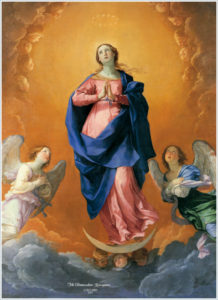 The 8th of December is the Feast of the Immaculate Conception which compared to the other holy days of this list is a relatively recent feast day first instituted in 1708 as a Holy Day of Obligation in the Roman Catholic Church that falls during the liturgical season of Advent which is a time of penitence and spiritual preparation for Christmas. The feast itself commemorates the dogma of the Immaculate Conception of the Blessed Virgin Mary which states that from the moment of her conception the Virgin Mary was preserved from original sin. Despite its comparatively recent institution as a universal feast, this day has become a special part of the holiday season and in many countries throughout the world it is a public holiday with parades, fireworks, family gatherings and of course religious observances. The Feast of the Immaculate Conception is the patronal feast of the United States and traditionally in Catholic circles it is on this day that people send out Christmas cards.
The 8th of December is the Feast of the Immaculate Conception which compared to the other holy days of this list is a relatively recent feast day first instituted in 1708 as a Holy Day of Obligation in the Roman Catholic Church that falls during the liturgical season of Advent which is a time of penitence and spiritual preparation for Christmas. The feast itself commemorates the dogma of the Immaculate Conception of the Blessed Virgin Mary which states that from the moment of her conception the Virgin Mary was preserved from original sin. Despite its comparatively recent institution as a universal feast, this day has become a special part of the holiday season and in many countries throughout the world it is a public holiday with parades, fireworks, family gatherings and of course religious observances. The Feast of the Immaculate Conception is the patronal feast of the United States and traditionally in Catholic circles it is on this day that people send out Christmas cards.
 As we draw closer to the winter solstice and of course Christmas, we come to the feast of Saint Lucy on the 13th of December. Saint Lucy was a young martyr from Syracuse, Sicily who met a gruesome death at the hands of her Pagan captors when she refused to make a sacrifice on behalf of the provincial governor as to do so would go against her Christian faith. She was known for great acts of charity towards the poor even going as far as to distribute her considerable personal fortune and jewels to those less fortunate. Her captors first attempted to burn her at the stake but the wood would not ignite around her so she met her martyrdom by sword after which her eyes were gouged from her head, but when she was laid to rest in her family mausoleum it was discovered they her eyes had mysteriously reappeared. Due to this legend, she became known as the patron saint of the blind and those who suffer from eye diseases. Due to the fact that her feast day falls during the darkest days of the year, Saint Lucy’s day has become known as a festival of light especially in Scandinavia where the winters and long and dark. In the northern European countries it is common for the youngest daughter of a family to bring her parents breakfast in bed on Saint Lucy’s Day while wearing a crown of lit candles. Lighting candles is a traditional part of Scandinavian St. Lucy’s Day celebrations as well as the general Christmas season to bring light into the darkest days of the year and as a reminder that the days will soon grow longer. I have never personally celebrated Saint Lucy’s Day, although I do admire her as a great saint and example of charity and piety. I did once visit a shrine dedicated to her in northern Portugal and have beautiful memories of lighting a candle and seeking her blessing and protection.
As we draw closer to the winter solstice and of course Christmas, we come to the feast of Saint Lucy on the 13th of December. Saint Lucy was a young martyr from Syracuse, Sicily who met a gruesome death at the hands of her Pagan captors when she refused to make a sacrifice on behalf of the provincial governor as to do so would go against her Christian faith. She was known for great acts of charity towards the poor even going as far as to distribute her considerable personal fortune and jewels to those less fortunate. Her captors first attempted to burn her at the stake but the wood would not ignite around her so she met her martyrdom by sword after which her eyes were gouged from her head, but when she was laid to rest in her family mausoleum it was discovered they her eyes had mysteriously reappeared. Due to this legend, she became known as the patron saint of the blind and those who suffer from eye diseases. Due to the fact that her feast day falls during the darkest days of the year, Saint Lucy’s day has become known as a festival of light especially in Scandinavia where the winters and long and dark. In the northern European countries it is common for the youngest daughter of a family to bring her parents breakfast in bed on Saint Lucy’s Day while wearing a crown of lit candles. Lighting candles is a traditional part of Scandinavian St. Lucy’s Day celebrations as well as the general Christmas season to bring light into the darkest days of the year and as a reminder that the days will soon grow longer. I have never personally celebrated Saint Lucy’s Day, although I do admire her as a great saint and example of charity and piety. I did once visit a shrine dedicated to her in northern Portugal and have beautiful memories of lighting a candle and seeking her blessing and protection.
I hope you have enjoyed this brief look at a few of the special holidays and observances associated with the Christmas season and I wish you have a truly magical holiday season and abundant blessings in the New Year!
La Santa Compaña
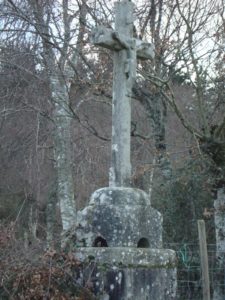 On a chilly night, amidst the verdant countryside of northwestern Spain, a local who has stayed late into the evening visiting a friend or perhaps a tourist who has wandered off the beaten path, meanders happily down a rural road to his home or place of lodging. The night is pitch black and an unseasonable cold permeates the air as thick mists roll in from all directions. The traveler notices in the distance a long line of what first appear to be flickering lights but as they draw closer are clearly seen to be human figures. At first the traveler is perplexed but quickly assumes these robed candle bearing nightwalkers to be on some sort of pilgrimage and he is not entirely wrong. It is a pilgrimage from beyond the grave known as the Santa Compaña, a manifestation of the Holy Souls in Purgatory who remind the locals of the fleetingness of life and the need to ever pray for their dead departed to help them on their journey to Heaven. As these unearthly pilgrims draw close, our traveler will see that they perhaps have the face of a skeleton or the pallid features and blank eyes of those not of this world and doubtless he will not stay long. If he is a local, he may make the sign of the cross and trace a sacred symbol into the dirt and lay there with his eyes closed until the spectral procession has passed or if he is unfamiliar with local customs, he may just run in the opposite direction. Either way he will never forget his encounter with the Santa Compaña.
On a chilly night, amidst the verdant countryside of northwestern Spain, a local who has stayed late into the evening visiting a friend or perhaps a tourist who has wandered off the beaten path, meanders happily down a rural road to his home or place of lodging. The night is pitch black and an unseasonable cold permeates the air as thick mists roll in from all directions. The traveler notices in the distance a long line of what first appear to be flickering lights but as they draw closer are clearly seen to be human figures. At first the traveler is perplexed but quickly assumes these robed candle bearing nightwalkers to be on some sort of pilgrimage and he is not entirely wrong. It is a pilgrimage from beyond the grave known as the Santa Compaña, a manifestation of the Holy Souls in Purgatory who remind the locals of the fleetingness of life and the need to ever pray for their dead departed to help them on their journey to Heaven. As these unearthly pilgrims draw close, our traveler will see that they perhaps have the face of a skeleton or the pallid features and blank eyes of those not of this world and doubtless he will not stay long. If he is a local, he may make the sign of the cross and trace a sacred symbol into the dirt and lay there with his eyes closed until the spectral procession has passed or if he is unfamiliar with local customs, he may just run in the opposite direction. Either way he will never forget his encounter with the Santa Compaña.
This otherworldly procession is common in northwestern Spain in the regions of Galicia, Asturias and parts of northern Castilla and León and is known by many names including “As de nuite” or The Night Ones and “La Estantigua” or Ancient Host but its most common name by far is the Santa Compaña which translates to English as the Holy Company. No matter what these ghostly night walkers are called, there is no denying that they are a manifestation of the dead in the world of the living. Many country dwellers in northwestern Spain even today claim to have witnessed the Santa Compaña and similar beliefs exist in Brittany, in northwestern France, regarding nocturnal ghostly processions. This is perhaps due to these locations’ shared ancient Celtic roots. The Santa Compaña is believed to be led by a living person who is called forth from his sleep by a mysterious force to roam the country side carrying a cross or cauldron of holy water followed by suffering souls who come forth from Purgatory. The person in question can be male or female depending on the gender of the patron saint of the local parish church and he or she will return to bed at dawn and awake feeling tired but with no recollection of his or her nocturnal wonderings. The role of Santa Compaña leader can be passed on to another person if they happen to come into contact with the ghostly procession. At times the Santa Compaña can be felt but not fully seen. In these cases it can manifest in the form of a chilly patch of air on an otherwise mild night or sometimes the faint flickers of lights can be seen in the distance and the unmistakable scent of candle wax wafting in on the night air will be detected when the Santa Compaña is afoot. There are several ways to protect oneself from potential harm brought about by an encounter with the Santa Compaña. The quickest and most effective defense is to make the sign of the cross and lay flat on the ground until it passes avoiding eye contact at all costs as this is the means by which a person may be compelled to become the new leader of the Santa Compaña. In Galicia, many villages have stone crosses mounted at crossroads and other rural locations called “Cruceiros.” If you can make it to the nearest cruceiro, you will surely emerge unscathed from this otherworldly encounter. It also never hurts to carry with you a small cross or holy symbol in case you are caught off guard by any type of supernatural manifestation.
People have asked me if I believe in the Santa Compaña and the answer is yes, without a doubt. In fact I believe I may have seen it on All Saints’ Day in 2001 as I was riding on a bus through Galicia on my way to Portugal. Galicia and northern Portugal are hotbeds of spiritual activity and witchcraft flourishes there, but that is a topic for another post. It was a beautiful night and we passed many rural graveyards that were glowing with lit candles people had placed on the graves of loved ones. As we rounded a bend on the edge of a mountain I remember looking down into the valley below and seeing a line lights floating in midair and meandering through the dense forest. I did not get a close look, but my psychic sense did tell me that it was something not of this world and I do believe I had a fleeting encounter with the Santa Compaña albeit from the relative safety of the inside of a moving tour bus.
The Santa Compaña may seem frightening but I assure you it is nothing to be feared. It is simply a manifestation of souls who are undergoing purification that are in need of prayers and reach out to those of us still alive to pray on their behalf. In Catholic theology, there exists an intermediate state between this earthly life and Heaven call purgatory where the souls of the departed are purified and cleansed of the imperfections of this life before entering Paradise. Similar states of waiting exist in Eastern Orthodoxy and Islam before the final judgement and in Hinduism and Buddhism before a soul’s next incarnation, but in Catholicism a greater emphasis is placed on purification. Souls call me helped through purgatory more quickly by means of prayers, masses and indulgences (a special remission of time in purgatory granted by the church for performing certain prayers and pious acts) offered for them by the living faithful still on Earth. In my personal experience, many cases of “hauntings” are in fact souls in Purgatory reaching out to the living for help in order to speed their purification and entrance into Heaven. This is the case with the Santa Compaña. The belief about the bewitched living person leading the procession is most likely a colorful embellishment on the part of imaginative country folk, but the procession of Holy Souls I’m convinced is completely real and serves as a reminder of the fleetingness of this life and the need to pray for those who have entered eternity. It is incredibly important to pray for the dead and help them on their passage to a happy afterlife and they in turn will not forget us but become our powerful friends and benefactors and help us in this life and the next.
I hope you have enjoyed this post and I thank you for taking the time to visit my blog. As always, I wish you peace, happiness and abundant blessings!
Erzulie’s Champagne Bubble Bath
Erzulie’s Champagne Bubble Bath
 The fall season is drawing to a close are we are in the midst of celebrating Halloween, All Saints’ Day and All Souls’ Day. This is truly my favorite time of year! I have decided to share the following ritual for a spiritual bubble bath to drawn wealth and luck into our lives for two reasons. Firstly, because we are heading into the winter months and one of my favorite things to do during this dark, cold time of year is to take long candle lit baths while listening to music of just meditating quietly and secondly because we are coming up of the end of the year and this bath is a good way to start the new year with a spirit of luck, wealth and luxury.
The fall season is drawing to a close are we are in the midst of celebrating Halloween, All Saints’ Day and All Souls’ Day. This is truly my favorite time of year! I have decided to share the following ritual for a spiritual bubble bath to drawn wealth and luck into our lives for two reasons. Firstly, because we are heading into the winter months and one of my favorite things to do during this dark, cold time of year is to take long candle lit baths while listening to music of just meditating quietly and secondly because we are coming up of the end of the year and this bath is a good way to start the new year with a spirit of luck, wealth and luxury.
I developed this simple ritual years ago not only as a means of summoning luck and money, but also out of a genuine love for taking baths. My favorite time of year to do this ritual is during the cold winter months when everything is dark and grey and we are in need of a boost of positive, relaxing and comforting energy. This service works with the energy of Erzulie Freda who in Haitian Vodou is the embodiment of wealth, love and luxury. Her colors are pink and light blue and her favorite offering is champagne. If the cost of champagne is prohibitive, you can use sparkling wine.
You will need:
Bubble bath
1 pink rose
1 pink candle
1 light blue candle
A bottle of champagne or sparkling wine
2 Glasses
Draw a hot bath and add the bubble bath.
Light the pink and blue candles somewhere in the bathroom and pour a glass of champagne as an offering for Erzulie and place it between the candles.
Add the petals of the pink rose to the bath.
Pour yourself a glass of champagne and soak in the tub as long as you’d like enjoying your glass of champagne.
Imagine great wealth coming into your life and money falling down from the sky and piling up around you.
Enjoy the bath and long as you’d like and when you’re finished simply get out and dry yourself as you normally would.
Allow the candles to burn out on their own.
I hope you have enjoyed this post and that you give this amazing bath and ritual a try. Thank you for taking the time to read my blog and I wish you peace, happiness and abundant blessings!
The Ofrenda for the Mexican Days of the Dead
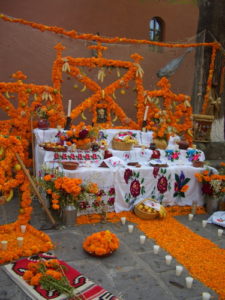 An altar is a portal into the spiritual world, a channel through which we may summon spiritual energy into our lives and commune with our ancestors, spirit guides and saints. Today I would like to discuss a specific type of altar: The Ofrenda for the Mexican Days of the Dead. From October 31st through the 2nd of November, families throughout Mexico celebrate the Days of the Dead which are a time to remember loved ones who have passed. This celebration has its roots in a fusion of traditions and beliefs belonging to ancient Aztec religion and Spanish Catholicism. This festive period is marked with parades, feasting, visits to the cemetery to clean and decorate the graves of loved ones and religious observances. One of the main traditions associated with Los Días de los Muertos is the construction of a special ancestral altar that is only in place for a few days this time of year: The Ofrenda.
An altar is a portal into the spiritual world, a channel through which we may summon spiritual energy into our lives and commune with our ancestors, spirit guides and saints. Today I would like to discuss a specific type of altar: The Ofrenda for the Mexican Days of the Dead. From October 31st through the 2nd of November, families throughout Mexico celebrate the Days of the Dead which are a time to remember loved ones who have passed. This celebration has its roots in a fusion of traditions and beliefs belonging to ancient Aztec religion and Spanish Catholicism. This festive period is marked with parades, feasting, visits to the cemetery to clean and decorate the graves of loved ones and religious observances. One of the main traditions associated with Los Días de los Muertos is the construction of a special ancestral altar that is only in place for a few days this time of year: The Ofrenda.
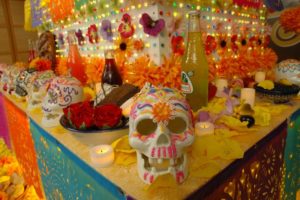 Ofrenda means offering and that is precisely what the Days of the Dead altar is, an offering to one’s ancestors and loved ones who return to their homes and families during these few days each year. It is an altar built specifically for this time of year on which foods items such as pan de muerto (a sweet bread often marked with a skull and bones) dishes that the deceased enjoyed in life, tequila, sugar skulls representing the dear departed, images of saints as well as photographs of deceased loved ones and of course bucket loads of orange marigolds (known as cempasúchil in Mexican Spanish) which grow in abundance this time of year throughout Mexico. The ofrenda not only serves as an offering to the dead but a place where returning spirits may congregate and commune with their living relatives. Families often gather around the ofrenda, pray together and enjoy food and conversation while feeling the presence of their ancestors. Often times on the evening of October 31st, there is an official welcoming ceremony for the ancestors where copal incense is burned at the ofrenda and candles are lit to officially greet the dead and invite them into the home. The construction of the ofrenda, in addition to being artistic and beautiful, is a deeply spiritual ritual that fosters communion among family members living and dead as the veil between the spiritual and physical worlds is lifted.
Ofrenda means offering and that is precisely what the Days of the Dead altar is, an offering to one’s ancestors and loved ones who return to their homes and families during these few days each year. It is an altar built specifically for this time of year on which foods items such as pan de muerto (a sweet bread often marked with a skull and bones) dishes that the deceased enjoyed in life, tequila, sugar skulls representing the dear departed, images of saints as well as photographs of deceased loved ones and of course bucket loads of orange marigolds (known as cempasúchil in Mexican Spanish) which grow in abundance this time of year throughout Mexico. The ofrenda not only serves as an offering to the dead but a place where returning spirits may congregate and commune with their living relatives. Families often gather around the ofrenda, pray together and enjoy food and conversation while feeling the presence of their ancestors. Often times on the evening of October 31st, there is an official welcoming ceremony for the ancestors where copal incense is burned at the ofrenda and candles are lit to officially greet the dead and invite them into the home. The construction of the ofrenda, in addition to being artistic and beautiful, is a deeply spiritual ritual that fosters communion among family members living and dead as the veil between the spiritual and physical worlds is lifted.
Building an ofrenda is quite simple. I have done it for the past several years simply by decorating my existing home altar more elaborately with sugar skulls, photos of deceased loved ones and a bouquet of flowers for each saint as well as an extra one for all my loved ones on the other side. I currently live in Europe where it’s hard to find the traditional Mexican marigolds, so I usually have a local florist make several bouquets with carnations which are the traditional flowers in this part of the world for All Saints’ and All Souls’ Days. I have also ordered papel picado, colorful banners made out of tissue paper depicting images of smiling, happy skeletons, and strung it across my altar and throughout my home during this special time of year. If you wish you create a Days of the Dead ofrenda, simply find any flat surface or table in your home and place photos of your departed loved ones or simply write their names out on paper. The Days of the Dead include the Feast of All Saints (November 1st), so definitely place any saint statues or images that you have on hand on your altar and decorate as you wish. Most importantly be sure to place a few food offerings, some flowers and light a candle to welcome your departed loved ones back to this world and remember to offer some prayers for them to have a happy and peaceful life on the other side. Since November is the month of the Holy Souls in Purgatory in Catholic tradition, I keep a white candle burning for them the entire month.
I hope you have found this post informative and that you are enjoying the beautiful autumn season. I know I am looking forward to Halloween and this special times of year when we are in such close contact with loved ones on the other side.
As always, I wish you peace, happiness and abundant blessings!